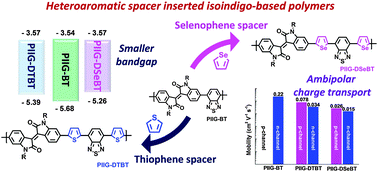Use of heteroaromatic spacers in isoindigo-benzothiadiazole polymers for ambipolar charge transport†
Abstract
Inspired by the outstanding charge-transport characteristics of poly(isoindigo-alt-benzothiadiazole) (PIIG-BT) in our previous study, herein we present two new polymers (PIIG-DTBT and PIIG-DSeBT) involving IIG and BT blocks constructed using five-membered heteroaromatic spacers such as thiophene (T) and selenophene (Se) and investigate the effects of the spacer groups on the optical, electrochemical, and charge-transport properties. As a consequence of the red-shifts induced by the more extended conjugation and enhanced intramolecular charge transfer (ICT), both PIIG-DTBT and PIIG-DSeBT show smaller bandgaps compared to PIIG-BT. Interestingly, the LUMO energy levels (−3.57 eV) for the two polymers are the same, but the HOMO levels (−5.39 and −5.26 eV for PIIG-DTBT and PIIG-DSeBT, respectively) clearly vary as a function of the structural modification of the spacers. In addition to the changes in their optical properties and energy levels induced by the incorporation of the spacers, ambipolar charge transport behaviors with hole and electron mobilities of up to 7.8 × 10−2 and 3.4 × 10−2 cm2 V−1 s−1, respectively, are observed for PIIG-DTBT films with highly ordered lamellar packing. This represents the second example of IIG-based polymers exhibiting ambipolar charge transport in OFETs reported to date.

- This article is part of the themed collection: Organic Field Effect Transistors

 Please wait while we load your content...
Please wait while we load your content...